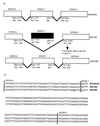Point mutations in the murine fumarylacetoacetate hydrolase gene: Animal models for the human genetic disorder hereditary tyrosinemia type 1
- PMID: 11209059
- PMCID: PMC14641
- DOI: 10.1073/pnas.98.2.641
Point mutations in the murine fumarylacetoacetate hydrolase gene: Animal models for the human genetic disorder hereditary tyrosinemia type 1
Abstract
Hereditary tyrosinemia type 1 (HT1) is a severe autosomal recessive metabolic disease associated with point mutations in the human fumarylacetoacetate hydrolase (FAH) gene that disrupt tyrosine catabolism. An acute form of HT1 results in death during the first months of life because of hepatic failure, whereas a chronic form leads to gradual development of liver disease often accompanied by renal dysfunction, childhood rickets, neurological crisis, and hepatocellular carcinoma. Mice homozygous for certain chromosome 7 deletions of the albino Tyr; c locus that also include Fah die perinatally as a result of liver dysfunction and exhibit a complex syndrome characterized by structural abnormalities and alterations in gene expression in the liver and kidney. Here we report that two independent, postnatally lethal mutations induced by N-ethyl-N-nitrosourea and mapped near Tyr are alleles of Fah. The Fah(6287SB) allele is a missense mutation in exon 6, and Fah(5961SB) is a splice mutation causing loss of exon 7, a subsequent frameshift in the resulting mRNA, and a severe reduction of Fah mRNA levels. Increased levels of the diagnostic metabolite succinylacetone in the urine of the Fah(6287SB) and Fah(5961SB) mutants indicate that these mutations cause a decrease in Fah enzymatic activity. Thus, the neonatal phenotype present in both mutants is due to a deficiency in Fah caused by a point mutation, and we propose Fah(5961SB) and Fah(6287SB) as mouse models for acute and chronic forms of human HT1, respectively.
Figures



Similar articles
-
Tissue-specific FAH deficiency alters sleep-wake patterns and results in chronic tyrosinemia in mice.Proc Natl Acad Sci U S A. 2019 Oct 29;116(44):22229-22236. doi: 10.1073/pnas.1904485116. Epub 2019 Oct 14. Proc Natl Acad Sci U S A. 2019. PMID: 31611405 Free PMC article.
-
Structural and functional analysis of missense mutations in fumarylacetoacetate hydrolase, the gene deficient in hereditary tyrosinemia type 1.J Biol Chem. 2001 May 4;276(18):15225-31. doi: 10.1074/jbc.M009341200. Epub 2001 Jan 22. J Biol Chem. 2001. PMID: 11278491
-
Mutational spectrum of Mexican patients with tyrosinemia type 1: In silico modeling and predicted pathogenic effect of a novel missense FAH variant.Mol Genet Genomic Med. 2019 Dec;7(12):e937. doi: 10.1002/mgg3.937. Epub 2019 Sep 30. Mol Genet Genomic Med. 2019. PMID: 31568711 Free PMC article.
-
Animal models of tyrosinemia.J Nutr. 2007 Jun;137(6 Suppl 1):1556S-1560S; discussion 1573S-1575S. doi: 10.1093/jn/137.6.1556S. J Nutr. 2007. PMID: 17513424 Review.
-
Molecular Aspects of the FAH Mutations Involved in HT1 Disease.Adv Exp Med Biol. 2017;959:25-48. doi: 10.1007/978-3-319-55780-9_3. Adv Exp Med Biol. 2017. PMID: 28755182 Review.
Cited by
-
Fumarylacetoacetate hydrolase is involved in salt stress response in Arabidopsis.Planta. 2018 Aug;248(2):499-511. doi: 10.1007/s00425-018-2907-9. Epub 2018 May 21. Planta. 2018. PMID: 29785518
-
Somatic Liver Knockout (SLiK): A Quick and Efficient Way to Generate Liver-Specific Knockout Mice Using Multiplex CRISPR/Cas9 Gene Editing.Curr Protoc Mol Biol. 2020 Mar;130(1):e117. doi: 10.1002/cpmb.117. Curr Protoc Mol Biol. 2020. PMID: 32150344 Free PMC article.
-
mRNA-based therapy proves superior to the standard of care for treating hereditary tyrosinemia 1 in a mouse model.Mol Ther Methods Clin Dev. 2022 Jul 15;26:294-308. doi: 10.1016/j.omtm.2022.07.006. eCollection 2022 Sep 8. Mol Ther Methods Clin Dev. 2022. PMID: 35949297 Free PMC article.
-
Tyrosinemia type I and not treatment with NTBC causes slower learning and altered behavior in mice.J Inherit Metab Dis. 2016 Sep;39(5):673-682. doi: 10.1007/s10545-016-9949-6. Epub 2016 Jun 6. J Inherit Metab Dis. 2016. PMID: 27271696
-
Induced Liver Regeneration Enhances CRISPR/Cas9-Mediated Gene Repair in Tyrosinemia Type 1.Hum Gene Ther. 2021 Mar;32(5-6):294-301. doi: 10.1089/hum.2020.042. Epub 2020 Oct 16. Hum Gene Ther. 2021. PMID: 32729326 Free PMC article.
References
-
- Goldsmith L A, Laberge C. The Metabolic Basis of Inherited Disease. 6th Ed. Vol. 1. New York: McGraw–Hill; 1989. pp. 547–562.
-
- Berger R, van Faassen H, Smith G P A. Clin Chim Acta. 1983;134:129–141. - PubMed
-
- Overturf K, Al-Dhalimy M, Tanguay R, Brantly M, Ou C, Finegold M, Grompe M. Nat Genet. 1996;12:266–273. - PubMed
-
- Labelle Y, Phaneuf D, Leclerc B, Tanguay R M. Hum Mol Genet. 1993;2:941–946. - PubMed
Publication types
MeSH terms
Substances
LinkOut - more resources
Full Text Sources
Other Literature Sources
Medical
Molecular Biology Databases
Miscellaneous

